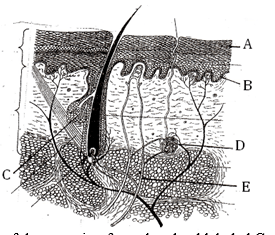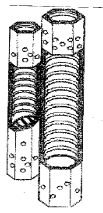QUESTIONS
- The scientific name of the cat is Felis Catus classify the cat into; (3mks)
- Kingdom………………………………………
- Genus…………………………………………
- Species………………………………………
- The figure below shows a structure of a tooth:
- Identify the tooth: - (1 mk)
- State how the tooth named in (a) is modified to perform its function:- (1 mk)
-
- Name the hormone secreted in the human body when one takes in a large amount of water:- (1 mk)
- Which disease results from inadequate production of the hormone named in (a) above? (1mk)
- Give two structural features that can be used to separate a housefly, a millipede, and a tick into their respective classes. (2mks)
- State three main functions of the stomach in human beings:- (3 mks)
- It was found that during germination of bean seeds, 9.2cm3 of carbon IV Oxide was produced while 9.0cm3 of oxygen was used up.
-
- the respiratory quotient of the reaction:- (2 mks)
- Identify the substrate being met abolished:- (1 mk)
- In which part of the cell does glycolysis occur? (1 mk)
-
- State three functions of the mammalian blood other than transport (3mks)
- Other than sexual intercourse name the other ways by which HIV/AIDS is spread (3mks)
- State three characteristics features of an efficient respiratory surface (3mks)
- State three environmental factors that affect the rate of stomatal transpiration (3mks)
- The cells shown below are adapted for transport in flowering plants.
- Name the tissue in which these cells are found. (1 mk)
- Identify and explain two observable features of these cells that adapt them to their role in transport. (2mks)
- Name two areas in human body where active transport takes place. (2mks)
- State the functions of the following cell organelles: (2mks)
- Nucleolus.
- Plasma membrane
- Distinguish between guttation and transpiration (2mks)
- What are the functions of the following parts of a light microscope? (3mks)
- Eye piece lens
- Condenser
- Diaphragm
-
- What is peristalsis? (1mks)
- Explain how the process above is brought about. (2mks)
-
- State three structural differences between arteries and veins in mammals (3mks)
- Name a disease that causes thickening and hardening of arteries (1mk)
- Identify two forces that help in upward movement of water in plants (2mks)
- State two reasons why lipids are rarely used as a respiratory substrate compound to Carbohydrates. (2mks)
- The equation below represents a metabolic process that occurs in the mammalian liver: (2mks)
Amino acids → organic compound + urea- Name the process
- What is the importance of the process to the mammals?
-
- Define the term balanced diet. (2mks)
- State the importance of roughage in a diet. (1mark)
- How do the following factors affect the rate of diffusion? (3marks)
- Surface area to volume ratio
- Diffusion gradient
- Temperature
- Name any three specialized plant cells. (3marks)
- Name three sites where gaseous exchange takes place in terrestrial plants. (3 marks)
- A student in form three caught an organism which had the following characteristics
- Body divided into two parts.
- Simple eyes.
- Eight legs.
Classify the organism up to the class level. (3 marks)
-
- Distinguish between the counter flow and parallel flow system in gaseous exchange(1mk)
- Which of the two systems mentioned in (a) above is efficient? Give a reason (2mks)
- Name the enzyme, the vitamin and the metallic ions required in the clotting of blood. (3mks)
- Enzyme
- Vitamin
- Metallic ion
- The figure below is a photomicrograph of a section of mammalian skin. Study it and answer the questions that follow.

- State two functions of the secretion frm the gland labeled C (2marks)
- Explain the behaviour of structure E when environmental temperature falls to 100c. (2marks)
- Astronauts from the outer space brought a material to earth. Explain how you would establish if the material is living or non-living. (2marks)
MARKING SCHEME
-
- animalia
- felis
- catus
-
- Incisor tooth (2 mks)
- Chisel shaped for cutting;
-
- Anti diuretic hormone / Vasopressin
- Diabetis insipidus
-
- Number of body parts.
- Number of legs
-
- Temporary storage of food
- Secretes digestive enzyme
- Secretes mucus - gastric juice
- Secretes Hcl - Endocrine function i.e. Gastrine hormone
-
-
- RQ = CO2 Produced
O2 Produced
= 9.2
9
= 1 - Carbohydrates
- RQ = CO2 Produced
- Cytoplasm-Regulation of body temperature
-
-
- Regulation of body p
- Defence through white blood cells
- prevents excessive bleeding platelets
- Allows the dehiate underlying tissues heal rapidly.
-
- sharing of sharp objects with infected perform
- blood transfusion of infected blood
- infected mother to child (breast feeding)
-
- Thin walls
- a moist inner surface
- a large combined surface area
- and a rich blood supply
-
- light
- temperature
- wind
- Atmospheric pressure
- humidity
-
- Xylem;
-
- Cross walls between successive vessel elements are performed, giving free passage of water from cell to cell;
- There is dissolution of cross walls within the vessel elements thus forming an open tube along the axis of the organ;
- Thick (cellulose ) / lignified wall / rings prevents collaps (under tention;
- Lack of long contents / hollow / empty allows free flow
- Wide lumen / cavity to ease flow / large volume;
- Stacked end to end / elongated forming a continuous tube. -
-
- Small intestines (in absorption of digested food)
- Kidney (in selective re – absorption
-
- Manufacture of ribosomes;
- encloses cell contents; regulate movement of materials in and out of the cell;
- Transpiration is the loss of water vapour, while gutation is loss or exudation of liquid water through hydathodes
-
- Magnify the object further;
- Concentrates light onto the object;
- Controls amount of light illuminating the object;
-
- Involuntary movement of food along the alimentary canal
- Rhythmic contraction and relaxation of the circular and longitudinal muscles along the gut;
-
-
Arteries Veins - Thick muscular - No valves (except pulmonary artery and aorta at the base- Narrow (small) lumen- Thin muscular walls - valves present;- Wide lumen (large) lumen; - Arteriosclerosis; reject Artheroma
-
-
- Transpiration pull; Capillarity;
- Cohesion and adhesive forces; Root pressure; -
-
- Not every soluble/not readily soluble therefore not easily transported to the site of respiration;
- A lot of oxygen is required to oxidize one gram of fat/liquid than one gram of glucose;
-
- Deamination;
-
- Removal of excess amino acids;
- Availing of energy in the body;
- Formation of glycogen /fats for storage; (award any one)
- Is a diet that consists of all classes of food / carbohydrates, protein, lipids, water, mineral salts and vitamins; taken in their right proportions for a healthy body; (2marks)
- Roughage add bulk to the food hence facilitating peristalsis / offer grip to prevent constipation; (i)
-
- The larger the surface area to volume ratio, the faster the rate of diffusion; (1mark acc. Reverse)
- Diffusion gradient; the higher the diffusion gradient (between two points) the faster the rate of diffusion; (1mark)
- Temperature- increase in temperature increases the rate of diffusion; (1mark)
-
- Root hair cell - Palisade cell - Parenchyma cell
- Epidermal cell -Guard cell - Companion cell
-
- Stomata
- Lenticels
- Cuticles
-
- Kingdom: Animalia. Rej: Animal or if first letter is small letter
- Phylum: Arthropoda rej. Anthropoda / Athropoda / Arthropod if first letter is small letter
- Class: Insecta rej Insect or if first letter is small letter
-
- Counter flow is a flow system in which blood and water (a fluid) flow in opposite directions within respiratory surfaces while parallel flow is a system in which blood and water (fluid) flow in the same direction within respiratory surfaces;
- Counter current flow; it increases efficiency in oxygenation of blood and maintains a steep concentration gradient;
-
- prothrombin
- K
- calcium ion
-
-
- Makes the skin and hair surface water proof.
- To protect the skin against infection by bacteria and viruses (it’s a mild antiseptic)
- Makes the skin and hair soft and supple
- The structure (blood vessel) constricts // contracts (vasoconstricts) and lies deeper in the skin so as to reduce heat loss from the body through radiation
-
- Living things will show characteristics like feeding, excretion, reproduction, gaseous exchange, movement, respiration; irritability; growth and development. (Any two)
Join our whatsapp group for latest updates
Tap Here to Download for 50/-
Get on WhatsApp for 50/-
Download Biology Paper 1 Questions and Answers - Form 3 End Term 2 Exams 2023.
Tap Here to Download for 50/-
Get on WhatsApp for 50/-
Why download?
- ✔ To read offline at any time.
- ✔ To Print at your convenience
- ✔ Share Easily with Friends / Students



